The most effective flower essence blending ratios for perfumes include the classic Rose-Jasmine (3:2:1), Lavender-Ylang Ylang (4:3:2), and Geranium-Neroli (2:2:1) combinations. You'll also find success with the Romantic Rose-Orange Blossom (3:3:1), Calming Chamomile-Lavender (2:4:1), Exotic Jasmine-Tuberose (1:3:2), and Traditional Rose-Violet (2:1:1) blends. Each ratio creates unique aromatic profiles, and understanding their nuances will transform your perfume-making journey.
The Classic Rose-Jasmine 3:2:1 Blend

While many perfumers experiment with different ratios, the classic 3:2:1 blend has stood the test of time for its balanced and harmonious composition.
When crafting a rose-jasmine blend, you'll want to start with your top note of jasmine, which comprises one part of your mixture. For the middle notes, use two parts of rose otto to create depth and character. Finally, anchor your blend with one part of a base note like vanilla absolute or patchouli. Take breaks to smell coffee beans during your blending process, as this will help refresh your olfactory palate.
You'll need to blend drop by drop, carefully recording each addition. Let your creation mature for several days to allow the scent to stabilize.
Test the blend on your skin with a carrier oil like jojoba wax, and adjust the ratios if needed based on your body chemistry.
Sweet Lavender-Ylang Ylang 4:3:2 Formula
You'll discover the perfect balance in this sweet floral blend by combining 4 parts lavender with 3 parts ylang ylang, creating a harmonious mix that promotes relaxation and emotional well-being.
The 4:3:2 formula leaves room for a top note of your choice, such as bergamot or sweet orange, to round out the aromatic profile.
For ideal results, you should let your blend mature for 48 hours in a dark bottle, allowing the lavender's calming middle notes to interweave with ylang ylang's deep base notes. This combination works exceptionally well in massage oil blends when paired with sweet almond oil as a carrier.
Relaxing Floral Balance Secrets
Creating a perfectly balanced relaxing floral blend requires understanding the delicate interplay between top, middle, and base notes.
To achieve this balance, you'll want to follow the 4:3:2 formula, which guarantees your fragrance has depth and longevity.
Start with 4 parts of base notes like Ylang Ylang or Sandalwood for a strong foundation.
Add 3 parts of middle notes, such as Lavender or Rose Geranium, to bind the scent together.
Finally, include 2 parts of top notes, which could be Lavender or other light florals, to create an inviting initial impression.
Test your blend on a fragrance strip and adjust the ratios to suit your preferences. The common ratio of 20% essential oils in eau de parfum ensures proper scent strength and staying power.
Remember that while Ylang Ylang can work across all three notes, it's most effective as a base note for its rich, lasting qualities.
Essential Oil Blend Proportions
Because essential oils vary in potency and character, mastering the Sweet Lavender-Ylang Ylang 4:3:2 formula requires careful attention to proportions. You'll need to balance 4 drops of Lavender (top note) with 3 drops of Ylang Ylang (middle note), and 2 drops of a base note like Patchouli or Sandalwood.
| Component | Blend Ratio |
|---|---|
| Lavender | 4 drops |
| Ylang Ylang | 3 drops |
| Base Note | 2 drops |
| Carrier Oil | 36 drops |
Remember to dilute your blend in carrier oil at a 20% concentration for safe skin application. The 4:3:2 ratio creates a harmonious balance between the invigorating Lavender, the floral depth of Ylang Ylang, and the grounding base note. Let your blend mature for several days to achieve its full aromatic potential.
Fresh Garden 2:2:1 Geranium-Neroli Mix
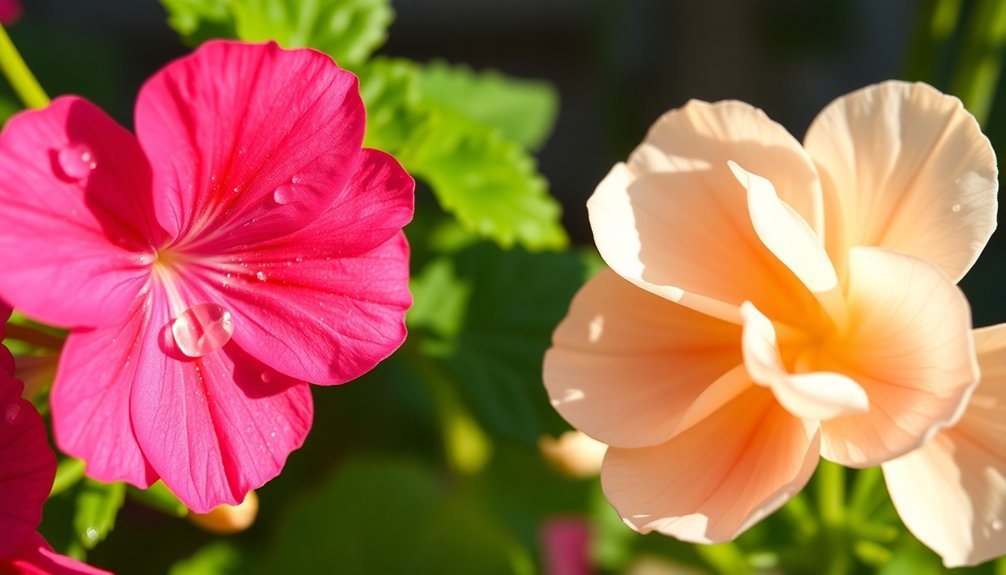
You'll find bright summer garden notes in this expertly balanced 2:2:1 geranium-neroli mix, where the floral elements create a fresh, uplifting blend.
The equal parts of geranium and neroli (2:2) provide a perfect equilibrium between hormonal harmony and emotional calm.
The resulting blend offers rich floral undertones that work beautifully together, making it an ideal choice for both perfumery and aromatherapy applications.
Bright Summer Garden Notes
The vibrant blend of geranium and neroli essential oils forms a stunning 2:2:1 ratio that captures the essence of a bright summer garden. You'll find this balanced mixture creates a perfect harmony, with each oil comprising 40% of the blend, leaving 20% for complementary notes.
| Oil Type | Percentage | Benefits |
|---|---|---|
| Geranium | 40% | Floral, fresh, uplifting |
| Neroli | 40% | Sweet, calming, balancing |
| Other Notes | 20% | Rounds out blend |
For the best results, apply this blend to your pulse points and gently massage into your skin. You can also create a roll-on perfume by mixing with jojoba oil. Remember to stay within the 2% concentration limit for floral blends, and you'll enjoy a perfectly balanced summer fragrance that's suitable for daily use.
Perfect Balance Proportions
Creating a perfectly balanced fresh garden perfume starts with mastering the 2:2:1 ratio of geranium and neroli essential oils. For a 200-drop blend, you'll need 20 drops each of geranium and neroli, plus 10 drops of a base note like cedar to anchor the scent.
You'll find that geranium provides a floral freshness while supporting hormonal balance, and neroli adds a sweet, calming element that soothes stress. The cedar base note grounds these lighter scents and guarantees longevity.
Test the blend on your skin to check how it interacts with your body chemistry, and don't hesitate to adjust the proportions to match your preferences.
Remember to keep the total essential oil content at 20% of your final volume, with the remaining 80% comprised of your carrier ingredients.
Floral Undertones Blend Well
When blending floral undertones for a fresh garden perfume, start with the proven 2:2:1 geranium-neroli mix to achieve a harmonious balance between sweet and calming notes.
You'll find that geranium's fresh, floral aroma perfectly complements neroli's sweet, soothing qualities.
For the best results, add bergamot or lavender as your third essential oil to enhance the blend's calming properties.
You can apply this mixture to your pulse points or add 5-10 drops to your diffuser.
Don't forget to dilute with a carrier oil like jojoba or coconut for skin applications.
Remember to store your blend in a cool, dark place and always perform a patch test before use.
If you're pregnant or have health concerns, consult your healthcare provider before trying new essential oil combinations.
Romantic 3:3:1 Rose-Orange Blossom Ratio
Romance flourishes in the delicate balance of a 3:3:1 rose-orange blossom ratio, where equal parts of rose and orange blossom essences create the heart notes, supported by a single part of base notes.
You'll want to use premium Rose Otto or Rosa Centifolia for the rose component, while Orange Flower Absolute delivers the perfect orange blossom character.
To craft this romantic blend, combine three parts each of rose and orange blossom essences for your heart notes.
Add one part of your chosen base notes, such as musk, amber, or teak wood, to ground the fragrance.
You'll need to fill the remaining volume with a carrier oil like jojoba or sweet almond.
Let your creation mature for at least a month to achieve the perfect harmony of scents.
Calming 2:4:1 Chamomile-Lavender Balance
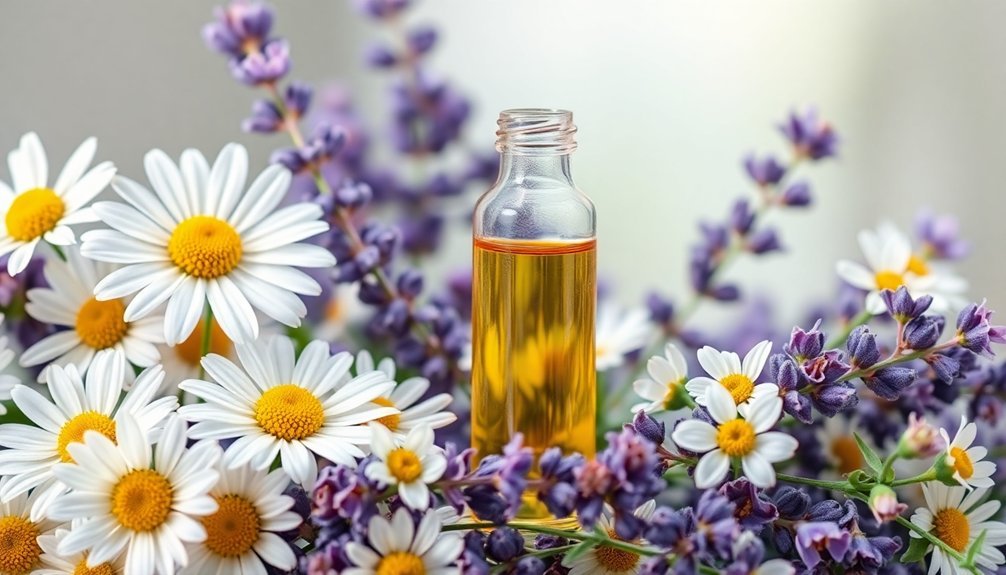
The gentle art of calming perfumery finds perfect expression in a 2:4:1 chamomile-lavender ratio, where lavender's soothing presence takes center stage.
You'll find this balance particularly effective, as lavender's stress-reducing properties blend harmoniously with chamomile's anti-inflammatory benefits.
To create this calming blend in a 10ml atomizer, you'll need 40 drops of essential oils distributed according to the 2:4:1 ratio.
Start with your base note at 14 drops, add 20 drops of lavender as your heart note, and finish with 6 drops of chamomile as your head note.
Complete the mixture with 7ml of alcohol and 1ml of distilled water.
This combination guarantees you'll achieve a perfectly balanced aroma that's both soothing and long-lasting.
Exotic 1:3:2 Jasmine-Tuberose Combination
Creating an exotic perfume starts with the bold 1:3:2 jasmine-tuberose combination, where tuberose's honey-like sweetness takes the lead.
You'll find that tuberose's narcotic depth dominates the blend, while jasmine adds its seductive, carnal notes in perfect proportion.
Gardenia's soft, creamy essence rounds out the composition with its zesty undertones.
To enhance this exotic blend, you can incorporate citrus notes like bergamot and mandarin, which'll brighten the jasmine while complementing gardenia's fresh qualities.
For added depth and longevity, consider layering with sandalwood or musk.
You'll discover that this ratio creates a harmonious balance, preventing the intense jasmine from overwhelming while allowing tuberose to shine and gardenia to soften the overall composition.
Traditional 2:1:1 Rose-Violet Harmony
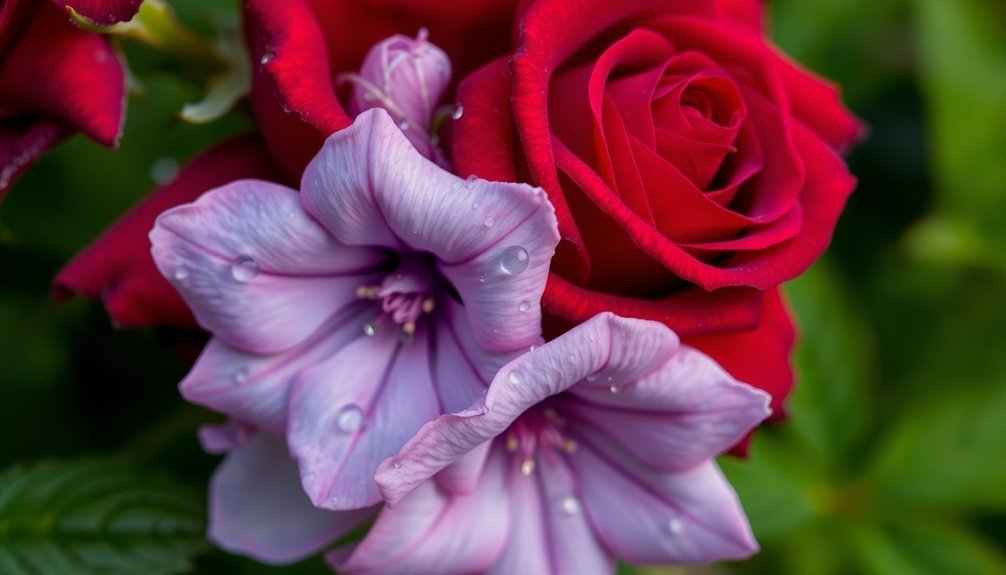
When crafting a timeless rose-violet harmony, you'll find the 2:1:1 ratio delivers an enchanting balance of floral notes.
However, it's essential to understand that this isn't a flower essence blend – you're working with perfume oils instead. While flower essences are for emotional well-being, your goal here is to create a lasting fragrance.
Start with your top notes, using twice the amount of bright citrus or light florals compared to your other components.
Then, add your middle notes of rose or jasmine, followed by base notes of violet or vanilla in equal parts.
Remember to test the blend at each stage and adjust according to your skin chemistry.
For longer-lasting results, stabilize your creation with a carrier oil, ensuring the scent develops beautifully throughout the day.
Frequently Asked Questions
How Long Do Flower Essence Perfumes Typically Last Before the Scent Fades?
You'll find that flower essence perfumes typically last 2-8 hours, depending on their concentration. Pure perfumes with 20-30% oils last up to 24 hours, while lighter concentrations fade within a few hours.
Can Pregnant Women Safely Use Flower Essence Perfume Blends?
Yes, you can safely use flower essences during pregnancy. They're highly diluted and contain only the flower's energetic imprint, not physical compounds. You won't experience any risks at any stage of your pregnancy.
What's the Best Time of Day to Harvest Flowers for Perfumes?
You'll want to harvest most flowers in early morning after dew evaporates but before heat sets in. However, some fragrant flowers like jasmine and tuberose are best picked late at night for peak aroma.
Do Flower Essence Perfumes Work Differently in Various Weather Conditions?
Yes, your flower essence perfumes will react differently based on weather. In heat, they'll evaporate faster and smell stronger. In cold, they'll stay closer to skin. Humidity affects longevity, making scents last longer.
Can Flower Essences Cause Allergic Reactions When Used in Perfumes?
Yes, you can experience allergic reactions to flower essences in perfumes. You'll notice symptoms like skin rashes, breathing issues, headaches, or nasal congestion if you're sensitive to specific floral compounds or essential oils.
In Summary
You've now learned seven time-tested flower essence ratios that'll help you create enchanting perfumes at home. Whether you're drawn to the classic rose-jasmine blend or prefer the exotic allure of jasmine-tuberose, these proportions give you a solid foundation for your perfume-making journey. Start with small batches to perfect your technique, and don't be afraid to adjust these ratios to match your personal scent preferences.
References
- https://www.immortalperfumes.com/blog/how-to-make-perfume-eau-de-parfum
- https://www.belayered.com/blogs/blog/how-to-make-perfume-from-flowers-1
- https://mockingbirdapothecary.com/blogs/mockingbird-blog/crafting-perfect-scents-an-essential-oils-blending-guide-for-beginners
- https://www.fesflowers.com/learn-about-flower-essences/other-faqs/
- https://africaimports.com/blog/the-ultimate-guide-to-making-perfume-with-essential-oils/
- https://theherbalacademy.com/blog/how-to-create-simple-perfume-blends-using-aromatic-notes/
- https://archive.org/stream/bzbzbzbzbzTechComm/Technical Communication/Improving Reading Skills 7e c.2013 – Spears_djvu.txt
- https://www.artliss.com/products/jasmine-rose-2
- https://unknown387.rssing.com/chan-6366207/latest.php
- https://basenotes.com/community/threads/confusion-about-ratios-top-middle-base-notes.305437/
- https://nikura.com/blogs/make-at-home/what-essential-oil-blends-well-with-ylang-ylang
- https://awaywithnature.com/products/organic-ylang-ylang-lavender-essential-oil-blend
- https://essentialthree.com/mixing-ratios-for-essential-oils-aroma-benefits/
- https://harnn.eu/en-de/products/signature-essential-oil-blend-ylang-ylang-lavender
- https://vivalabody.com/products/natural-perfume-lavender-ylang-ylang
- https://basenotes.com/community/threads/ylang-ylang-amber-formula-looking-for-feedback.528560/
- https://nikura.com/blogs/make-at-home/how-to-make-perfume
- https://nikura.com/blogs/make-at-home/lavender-sandalwood-ylang-ylang-candles
- https://www.joyelick.com/2016/02/diy-perfume-how-to-blend-essential-oils.html
- https://www.theplantguru.com/page/what-blends-well-with-ylang-ylang-essential-oil/

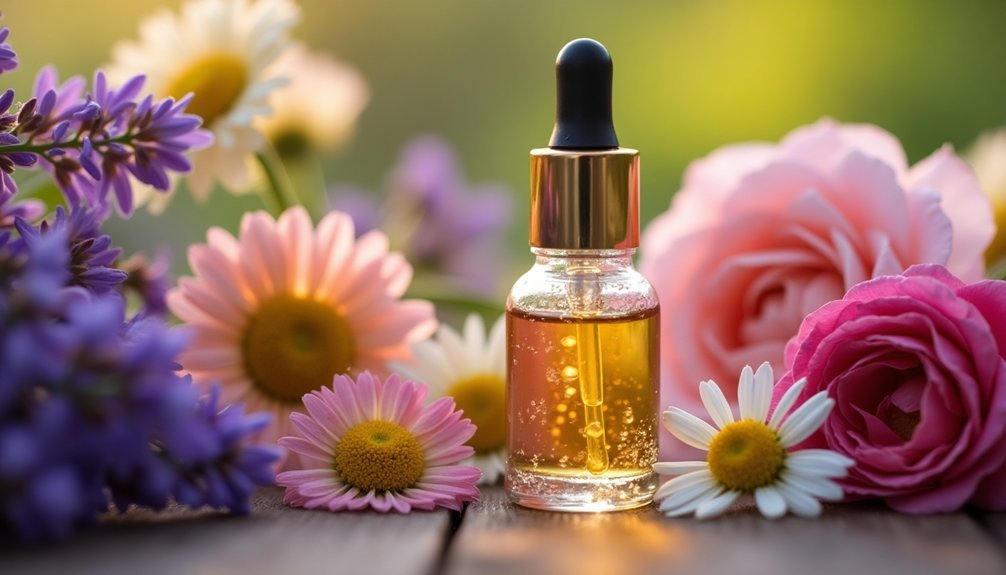
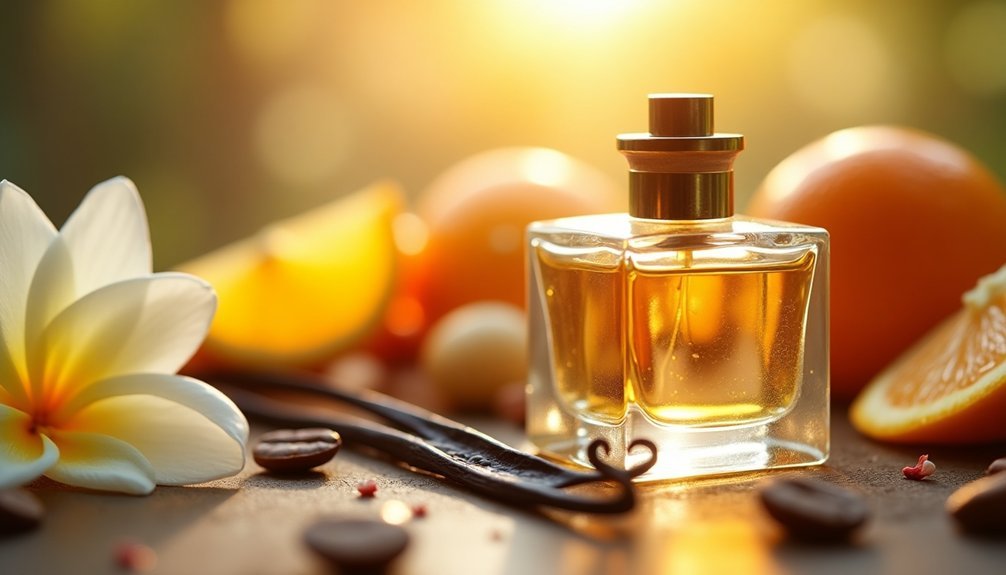

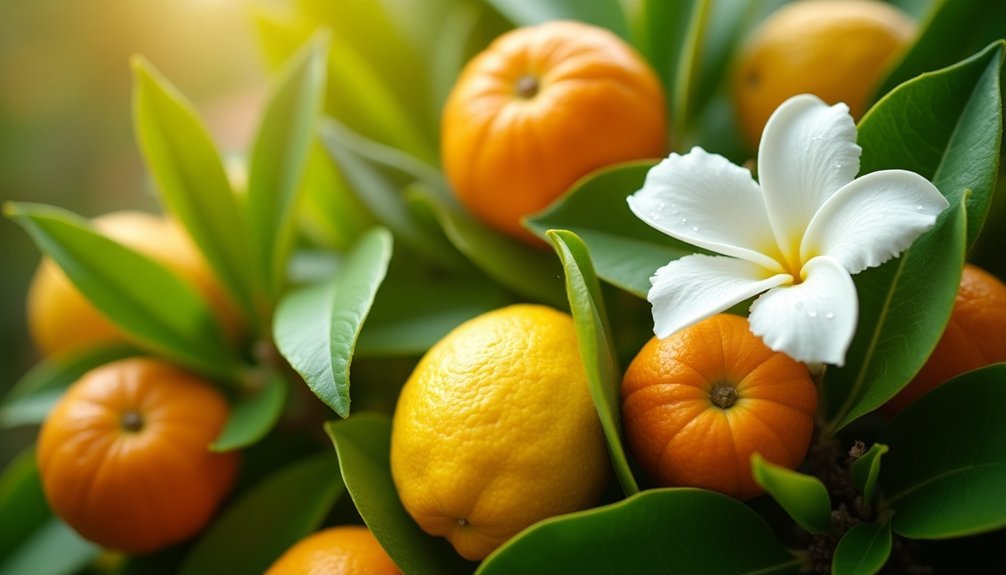
Leave a Reply